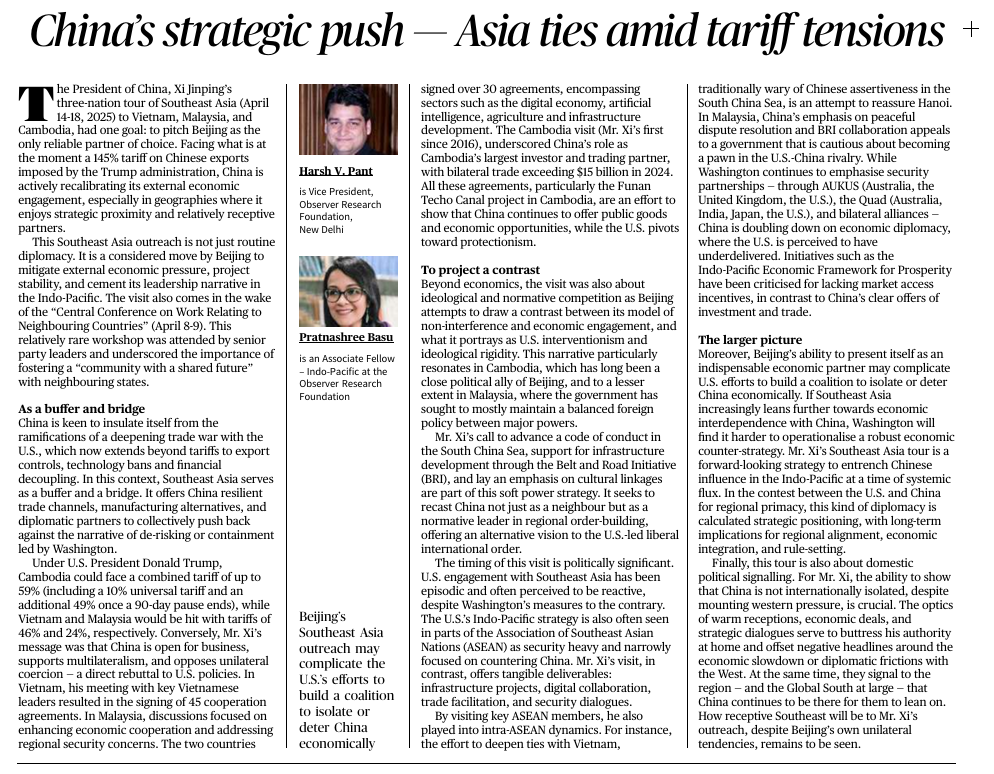Context: President Xi Jinping’s Visit to Southeast Asia (April 14–18, 2025)
- Countries visited: Vietnam, Malaysia, Cambodia.
- Objective: To present China as the “reliable partner of choice” in Southeast Asia.
- Background: Comes amid a 145% U.S. tariff on Chinese exports, initiated under the Trump administration.
- Broader goal: Recalibrating China’s external economic engagement, especially in regions where it has geostrategic proximity and economic receptivity.
2. Not Just Routine Diplomacy
- The visit was part of a deliberate strategy to:
- Reduce dependence on Western markets.
- Boost stability and leadership in the Indo-Pacific.
- Address economic pressure and enhance regional cooperation.
- Reduce dependence on Western markets.
- Coincided with the “Central Conference on Work Relating to Neighbouring Countries”, highlighting the importance of regional diplomacy.
3. Southeast Asia as a Buffer and Bridge
- Why Southeast Asia?
- Acts as a buffer to shield China from Western economic pressure.
- Serves as a bridge to diversify trade and economic ties.
- Acts as a buffer to shield China from Western economic pressure.
- Examples of tariff impact:
- Cambodia may face a 59% tariff (10% universal + additional 49%).
- Vietnam: 46% tariff.
- Malaysia: 24% tariff.
- Cambodia may face a 59% tariff (10% universal + additional 49%).
- China’s response:
- Pitched multilateralism and opposition to unilateralism.
- Promoted economic resilience and technology independence.
- Pitched multilateralism and opposition to unilateralism.
4. Strengthening Bilateral Economic Ties
- Vietnam: Signed 45 cooperation agreements.
- Cambodia: Over 30 agreements covering:
- Digital economy
- Artificial intelligence
- Smart agriculture
- Infrastructure
- Cambodia’s trade volume with China expected to exceed $15 billion in 2024.
- Funan Techo Canal project = showcase of China’s public goods model.
- Digital economy
5. To Project a Contrast to the U.S.
- China portrays itself as:
- A non-coercive, rule-setting leader.
- Opposed to the S. model of conditional aid, intervention, and military alliances.
- A non-coercive, rule-setting leader.
- In contrast to U.S.-backed groupings like:
- AUKUS, QUAD, Bilateral alliances.
- Indo-Pacific Economic Framework for Prosperity (IPEF), criticized for lacking trade incentives.
- AUKUS, QUAD, Bilateral alliances.
6. Emphasis on Regional Norm-Setting
- China’s soft power strategy focuses on:
- Norms of non-interference.
- Cultural linkages (e.g., BRI, Confucius Institutes).
- Alternative to the U.S.’s liberal international order.
- Norms of non-interference.
- China appeals to Southeast Asian countries that have been cautious of Western influence but also wary of becoming too dependent on China.
7. The Larger Strategic Picture
- Strategic Positioning:
- Presents China as an indispensable economic partner.
- Counterbalances U.S. decoupling and containment strategies.
- Ensures Southeast Asia is less susceptible to Western influence.
- Presents China as an indispensable economic partner.
- Challenges for the U.S.:
- Harder to isolate China economically.
- Difficulty in operationalizing a coherent Indo-Pacific strategy.
- Harder to isolate China economically.
8. Signalling to Global and Domestic Audiences
- Domestic signalling: Shows the Chinese public that:
- China is not isolated.
- It has alternatives amidst economic pressures and geopolitical tension.
- China is not isolated.
- Global signalling:
- China continues to engage diplomatically and economically.
- Reiterates its commitment to multilateralism and peaceful engagement.
- China continues to engage diplomatically and economically.
- Use of:
- Warm receptions, economic deals, and joint statements.
- Diplomatic overtures to shape narratives.
- Warm receptions, economic deals, and joint statements.
9. Takeaway
- Xi’s tour is strategically timed to:
- Reinforce China’s leadership in the Indo-Pacific.
- Push back against the U.S.-led narrative of economic isolation.
- Entrench China’s influence through economic statecraft and normative diplomacy.
- Reinforce China’s leadership in the Indo-Pacific.
Outcome uncertain: Depends on how receptive regional states are to China’s overtures amid underlying concerns.


